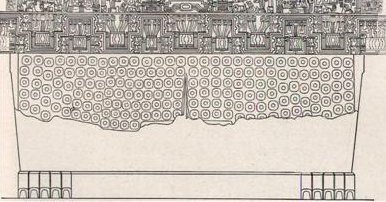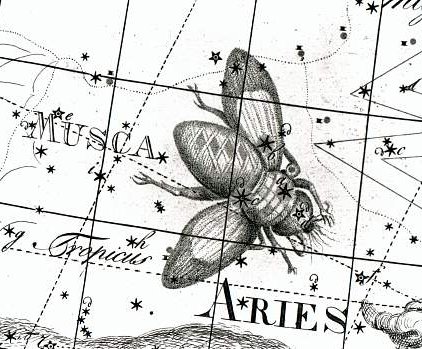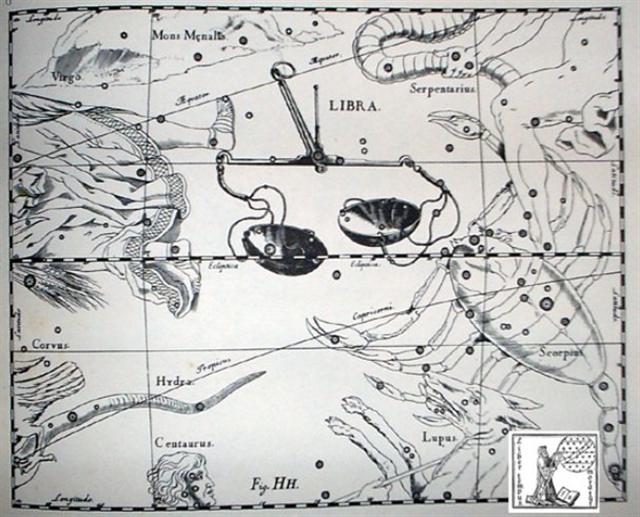Number 2 is reiterated in several ways in the text on page E:35.
And below the midline of Pachamama (the World Mother) the
day circles are drawn double:

... The 'sun symbols' in the skirt can
possibly be understood to represent the days of summer. Although
Posnansky reconstructed their number as 182 I believe he was
wrong. Only 94 + 83 = 177 are visible, and the extrapolated 5
are not necessary. The reason is that 177 = 6 * 29.5 or half a
year as defined by synodic lunar months.
On the other hand, the 'sun symbols' can
alternatively be read as double days, because each symbol has 2
rings. Maybe this is a better way to interpret the skirt. The
whole year will then be covered and the number of days will be
188 + 166 = 354. And the non-visible 5 symbols can represent 10
extracalendrical days, resulting in a satisfying 354 + 10 = 364
...
At the girdle of the Virgin was Spica:
| te hokohuki |
te moko |
vero
hia |
tagata honui |
e
ha mata |
|
Ha. 1. Four. 2. To breathe.
Hakaha'a, to
flay, to skin. Vanaga. 1. Four. P Mgv., Mq., Ta.: ha, id.
2. To yawn, to gape. 3. To heat. 4. Hakaha,
to skin, to flay; unahi hakaha, to scale
fish. Mgv.: akaha, to take to pieces, to take
off the bark or skin, to strip the leaves off
sugarcane. 5. Mgv: ha, sacred, prohibited.
Mq.: a, a sacred spot. Sa.: sa, id.
Churchill. |
 |
 |
 |
 |
 |
|
Cb8-4 |
Cb8-5
(172 + 4) |
Cb8-6
(177 = 6 * 29½) |
Cb8-7
(392 + 178 = 570) |
Cb8-8
(1½ * 314 + 100) |
|
CLOSE TO THE FULL
MOON: |
|
γ Hydrae (201.0), ι Centauri (201.4) |
Al Simāk-12 (Lofty) /
Chitra-14 (Bright One) /
Horn-1 (Crocodile) /
Sa-Sha-Shirū-20
(Virgin's Girdle) /
ANA-ROTO-3 (Middle pillar)
MIZAR = ζ Ursae Majoris
(202.4),
SPICA
= α Virginis,
ALCOR
= 80 Ursae Majoris
(202.7)
SADALMELIK (α Aquarii)
*161.0 = *202.4 - *41.4 |
71 VIRGINIS
(203.6) |
no star
listed (204) |
HEZE = ζ Virginis
(205.0),
Southern Pinwheel Galaxy = M83 Hydrae
(205.7) |
|
... Proclus
informs us that the fox star nibbles continuously at
the thong of the yoke which holds together heaven
and earth; German folklore adds that when the fox
succeeds, the world will come to its end. This fox
star is no other than Alcor, the small star g
near zeta Ursae Majoris (in India Arundati,
the common wife of the Seven Rishis, alpha-eta Ursae
...
 |
|
... Mons
Maenalus, at the feet of Boötes, was formed by
Hevelius, and published in his Firmamentum
Sobiescianum; this title coinciding with those
of neighboring stellar groups bearing Arcadian
names. It is sometimes, although incorrectly, given
as Mons Menelaus, - perhaps, as Smyth
suggested, after the Alexandrian astronomer referred
to by Ptolemy and Plutarch. The Germans know it as
the Berg Menalus; and the Italians as
Menalo. Landseer has a striking
representation of the Husbandsman, as he styles
Boötes, with sickle and staff, standing on this
constellation figure. A possible explanation of its
origin may be found in
what Hewitt writes in his Essays on the Ruling
Races of Prehistoric Times: The Sun-god thence
climbed up the mother-mountain of the Kushika race
as the constellation Hercules, who is depicted in
the old traditional pictorial astronomy as climbing
painfully up the hill to reach the constellation of
the Tortoise, now called Lyra, and thus attain the
polar star Vega, which was the polar star from 10000
to 8000 B.C.
May not this modern companion constellation, Mons
Maenalus, be from a recollection of this early Hindu
conception of our Hercules transferred to the
adjacent Bootes?
 |
|
Oct 8
(240 + 41) |
9 |
10 |
11 (364 - 80) |
12 (285) |
|
'Sept 11 (354 - 100) |
12 |
13 (256
= 4 * 64) |
14 |
15 |
|
"Aug 28
(240) |
HORA ITI 29 |
30 (242
= 2 * 11 * 11) |
31 |
HORA NUI 1 |
|
AHU
AKAPU |
PU
PAKAKINA A IRA |
|
Paka. 1. Dry; to become dry (of things);
pakapaka, to dry out. Te paka is also
the name of the moss-covered areas, between the
small lakes of volcano Rano Kau, through
which one can pass without getting one's feet wet.
2. To go, to depart; he-paka-mai, to come;
he-oho, he-paka, they go away. 3. To become calm
(of the sea): ku-paka-á te tai. Pakahera,
skull, shell, cranium; pakahera puoko tagata,
human skull; pakahera pikea, shell of crab or
crayfish. Gutu pakapaka, scabbed lips. Hau
paka, fibres of the hauhau tree, which
were first soaked in water, then dried to produce a
strong thread. Moa gao verapaka, chicken with
bald neck. Ariki Paka, certain collateral
descendents of Hotu Matu'a, who exercised
religious functions. Vanaga. 1. Crust, scab, scurf;
paka rerere, cancer; pakapaka, crust,
scabby. 2. Calm, still. 3. Intensive; vera paka,
scorching hot; marego paka, bald; nunu
paka, thin. 4. To arrive, to come. 5. To be
eager. 6. To absorb. 7. Shin T. Pakahera,
calabash, shell, jug. Pakahia, to clot,
curdle, coagulate. Pakapaka, dry, arid,
scorching hot, cooked too much, a desert, to fade
away, to roast, a cake, active; toto pakapaka,
coagulated blood; hakapakapaka, to dry, to
broil, to toast. Pakahera pikea, shell of
crab or crayfish. Churchill.
Kinana,
s. Haw., a hen that has hatched chickens.
Sam., tina, a
mother. Tong.,
tina-manu, a sow that had litter.
Tah., ti'a, the
lower part of the stomach, below the navel.
Fiji., tina,
mother; tina-tina, mother of inferior
animals. N.
Zeal., tinana, the buttocks, trunk, body.
This word, with
somewhat varying but not far separate meanings, I am
inclined to consider as related to the
Goth., kwens,
kwino, a woman; kwina-kunds and
kwineins, female; and possibly kwithus,
the womb, the stomach, if that is syncope of an
original kwinthus. Greek,
γυνη, woman ... |
|
CLOSE TO THE
SUN: |
|
April 8 |
9 |
10 (100) |
11 |
12 |
|
no star
listed (18) |
ADHIL
(Garment's Train) = ξ Andromedae
(19.3),
θ
Ceti (19.7) |
KSORA (Knee) = δ Cassiopeiae
(20.1),
ω
Andromedae (20.6),
γ
Phoenicis (20.8) |
δ
Phoenicis (21.5) |
υ Andromedae (22.9) |
|
'March
12 |
13 |
14 (73) |
15 |
16 |
|
"Febr 26 |
TE-HETUU-PU 27 |
28 (59) |
29 |
"March 1 |
 |
And counting twice 10 days ahead from glyph number 177 (at vero hia)
 |
19 |
 |
we will reach the day when the center of the Fly
was at the Full Moon:
... From a religious point of
view, the high regard for flies, whose increase or
reduction causes a similar increase or reduction in
the size of the human population, is interesting,
even more so because swarms of flies are often a
real nuisance on Easter Island, something most
visitors have commented on in vivid language. The
explanation seems to be that there is a parallel
relationship between flies and human souls, in this
case, the souls of the unborn. There is a widespread
belief throughout Polynesia that insects are the
embodiment of numinous beings, such as gods or the
spirits of the dead, and this concept extends into
Southeast Asia, where insects are seen as the
embodiment of the soul ...
| te maitaki |
kua hua te
kahi |
te ahine
poo puo |
ki te huaga |
ki te huaga |
te kahi |
|
Hua. 1. Testicle. 2.
Figuratively: son, hua tahi, only
son; fruits of the earth; to grow well (of
fruits). 3. To cause a fight, a quarrel. Hua-ai, generation, as lineage of
direct descendents; contemporaries.
Huahua, coccyx of bird,
'parson's nose': huahua moa, huahua uha.
Huataru, a
creeper (Chenopodium ambiguum).
Vanaga. 1. The same; ki hua, again,
to continue, to strain, to struggle, to
move, to repeat, over and above. Mq.: hua,
the same, to return, to recommence. 2. To
bloom, to sprout; flower, fruit (huaa);
huaa tae oko, huaa vahio,
young fruit; hua atahi, only son; huahaga, fruit;
mei te huahaga o
tokoe kopu, the fruit of thy body; tikea huahaga, deceptive appearance. P
Pau.: ua, to be born; huahaga,
lineage. Mgv.: hua, to produce (said
of trees, grain, etc.), blooming time of
flowers, abundance of fruit. Mq.: hua,
to produce, to bear fruit. Ta.: ua,
to sprout. Huahua. 1. Tailless fowl.
2. Vein, tendon, line. 3. Mgv.: huahua,
pimples covering the face. Ta.: huahua,
id. Mq.: hua, tubercules. Sa.: fuafua, abscess on hand or feet. Ma.:
huahua, small pimples. Pau.: Hua-gakau, rupture. Ta.:
áau,
entrails. Sa.: ga'au, id. Ma.: ngakau, id. Churchill. 1. Fruit. 2. Egg.
3. Tā
hua = 'genealogical writing' or 'same
writing'. Fischer.
Kahi. Tuna; two
sorts: kahi aveave, kahi matamata.
Vanaga. Mgv.: kahi, to run, to flow.
Mq.: kahi, id. Churchill. Rangitokona, prop up the heaven! //
Rangitokona, prop up the morning! // The
pillar stands in the empty space. The
thought [memea] stands in the
earth-world - // Thought stands also in the
sky. The kahi stands in the
earth-world - // Kahi stands also in
the sky. The pillar stands, the pillar - //
It ever stands, the pillar of the sky.
(Morriori creation myth according to Legends
of the South Seas.) |
 |
 |
 |
 |
 |
 |
|
Cb8-24 |
Cb8-25 |
Cb8-26 |
Cb8-27 |
Cb8-28 (199) |
Cb8-29 (584 + 8) |
|
CLOSE TO
THE FULL MOON: |
|
Oct 28 → Cb8-28 |
29 |
30 |
31 |
Nov 1 (305) |
2 |
|
ρ
Lupi (221.0),
TOLIMAN
(Shoot of the Grapevine) =
α
Centauri
(221.2),
π
Bootis (221.8),
ζ
Bootis (221.9) |
31 Bootis (222.0),
YANG MUN (South Gate) =
α
Lupi
(222.1),
RIJL AL AWWA (Foot of the Barker) =
μ
Virginis
(222.5),
ο
Bootis (222.9) |
IZAR (Girdle) =
ε
Bootis
(223.0),
109 Virginis,
α
Apodis (No Feet)
(223.3),
μ
Librae (223.8) |
Al Zubānā-14a
(Claws) /
Visakha-16 (Forked) /
Root-3 (Badger)
ZUBEN ELGENUBI
(Southern Claw)
=
α
Librae
(224.2),
ξ
Bootis,
ο
Lupi (224.5) |
KOCHAB
(Kakkab,
the Star) = β Ursae Min.
(225.0), ξ Librae (225.7) |
KE KWAN (Cavalry Officer) =
β
Lupi
(226.3),
KE KWAN =
κ
Centauri (226.4),
ZUBEN ELAKRIBI (Claw of the Scorpion) =
δ
Librae
(226.8),
π¹
Oct.
(226.9)
*185.0 = *226.4 - 41.4 |
|
'Oct 1 |
2 |
3 |
4 (277) |
5 |
6 |
|
"Sept 17 (364 - 104) |
18 (9 * 29 =
261) |
19 |
20 |
21 |
Equinox |
 |
|
CLOSE TO
THE
SUN: |
|
ν Arietis (38.5), δ, ε Ceti (38.8) |
μ
Arietis (39.4),
HEAD OF THE FLY = 35 Arietis
(39.6),
KAFFALJIDHMA (Part of a Hand) =
γ
Ceti,
θ
Persei (39.8) |
π
Ceti,
ο
Arietis (40.0),
ANGETENAR (Bend in the River) =
τ¹
Eridani,
μ
Ceti (40.2),
RIGHT WING = 39 Arietis
(40.9) |
Bharani-2 (Yoni) /
Stomach-17 (Pheasant)
π
Arietis (41.2),
MIRAM (Next to the Pleiades) =
η
Persei
(41.3),
BHARANI
= 41 Arietis (41.4),
τ²
Eridani,
σ
Arietis (41.7) |
TA LING (Great Mound) = τ
Persei
(42.4)
*1.0 = *42.4 - *41.4 |
ρ
Arietis (43.0),
GORGONEA SECUNDA =
π
Persei
(43.5),
ACAMAR (End of the River) =
θ
Eridani
(43.6),
ε
Arietis (43.7),
λ
Ceti (43.9)
DENEBOLA (β Leonis) |
 |
| Vai o
ero hia |
kua
tere |
ki te
marama |
kua
oho |
 |
 |
 |
 |
|
Cb9-1 (593 → 59 * 3 = 177) |
Cb9-2 |
Cb9-3 |
Cb9-4 (204) |
|
CLOSE
TO THE FULL MOON: |
|
Nov 3 |
4 |
5 |
6 (310) |
|
ω Bootis (227.2),
NEKKAR (Herdsman) = β Bootis
(227.3), σ Librae (227.5), π² Oct.
(227.7),
NADLAT (Mean Little Ones) = ψ Bootis
(227.8), π Lupi (227.9) |
15h (228.3)
ZUBEN HAKRABIM = ν Librae
(228.3), λ Lupi (228.9) |
ω
Oct. (229.3),
ι
Librae (229.6),
κ
Lupi (229.7),
ζ
Lupi (229.8) |
Al Zubānā-14b (Claws)
χ
Bootis (230.3),
PRINCEPS =
δ
Bootis
(230.6),
ZUBEN ELSCHEMALI
(Northern Claw) =
β
Librae
(230.8) |
 |
|
CLOSE
TO THE
SUN: |
|
May 4 (124) |
5 (5 * 5 * 5) |
6 |
7 |
|
MENKAR
(The Nose) = α Ceti
(44.7) |
3h (45.7)
GORGONEA TERTIA =
ρ
Persei
(45.1),
ALGOL
(The Demon) = β Persei
(45.9) |
ι
Persei (46.1),
MISAM (Next to the Pleiades) =
κ
Persei
(46.2),
GORGONEA QUARTA =
ω
Persei
(46.7),
BOTEIN (Pair of Bellies) =
δ
Arietis
(46.9) |
ζ Arietis (47.7) |
|
°April 30 (120) |
°May 1 (*41) |
2 |
3 |
|
'April 7 |
8 |
9 |
10 (100) |
|
"March 24 (83) |
Julian
equinox |
26 |
27 |
|
MARCH 1 |
2 |
3 |
4 (63 = 47 +
16) |
|
DAY 44 |
45 |
46 |
47 |
 |
|












